The Grote Markt is Antwerp’s compact main square. Here you can admire a monumental fountain and the many guild houses surrounding the square, as well as the city’s magnificent sixteenth-century city hall that dominates the square.

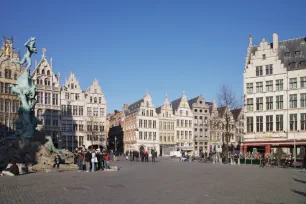
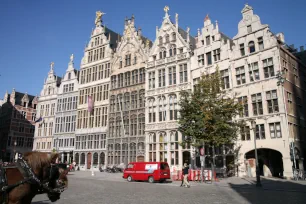
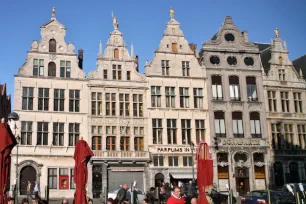
The square’s triangular shape originates from the municipal ground created during the era of the Franks, in the early Middle Ages. The name, which roughly translates into ‘large market’, was given to distinguish it from another market square now known as ‘kleine Markt’ (Small market).
Guild Houses
The Grote Markt is probably best known for the beautiful houses of the guilds which align the square. Guilds were associations of craftsmen or merchants, who practiced the same trade. They were particularly powerful in the Middle Ages but were abolished under French rule in 1796. Their administration was housed in a so-called guild house. The largest guild house in Antwerp was that of the butchers, which is situated to the north of the Grote Markt, but most other guilds built their houses at this square.
Pay attention to the statues at the top of the buildings. They often depict the patron saint of the particular guild.
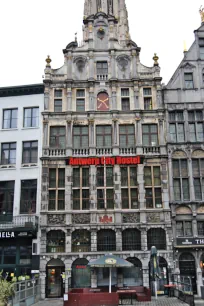
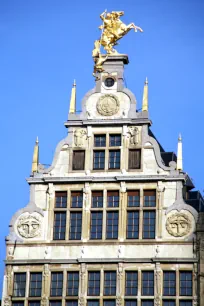
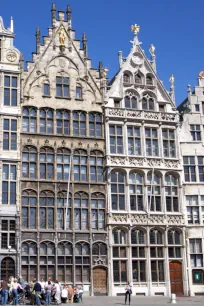
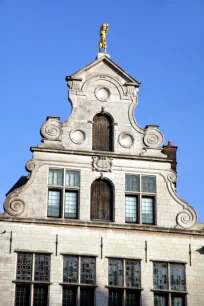
The oldest two guild houses can be found on the south side of the square. The oldest Baroque building is «Rodenborch» at no.40, the guild house of the skinners and cobblers. The facade dates from 1644, but the house is much older than that – its cellar dates back to the 13th century.
Next door is the former guild house of the shearmen and clothworkers. The original building burned down in 1541 and was rebuilt in an early Renaissance style. The building was originally used as a weighhouse, which is why the building is known as «De Balans», which translates into “the scale”. This explains why the gilded figure at the top of the gable is holding a scale.
The most photographed buildings, however, are on the opposite, north side of the square. The tallest is the «Spaengien» at no. 7, the guild house of the archers’ guild, who acquired the building in 1443. It was rebuilt in 1580-1582 in a Renaissance style after it burned down in 1576 during the Spanish Fury. At the top of the building is a large statue of the patron saint of the archers’ guild: Saint George, who is shown fighting a dragon. Below are two reliefs of archers with a crossbow.
The adjoining building on the left at no. 5 is «De Mouwe». The house was purchased in 1497 by the coopers’ guild. In 1579, three years after it burned down during the Spanish Fury, it was rebuilt in the Renaissance style. The building is crowned with a statue of the patron saint of the guild, St. Matthias, who is – as is tradition – depicted holding an axe.
The corner house on the left is «Den Engel». The original building from the 14th century burned down during the Spanish Fury in 1576 and was rebuilt in 1600 in the Renaissance style. It is crowned with a large statue of an angel.
The building at no. 9 is «De Spieghel» (The Mirror), the guild house of another archers’ guild. The original building dated back to the early 14th century, but the current building is a reconstruction from 1904. A niche near the top holds a statue of Saint Sebastian, the patron saint of archers.
The next building, at no. 11, is called «Den Arend» (The Eagle). Perched atop the building is a statue of – you guessed it – an eagle. The building’s origins go back to the 14th century, and it was used as the guild house of the joiners’ guild from 1456 until 1496. The guild of the ‘meerseniers’ (small retailers) acquired the building in 1529. In 1906 the building was demolished for the Neo-Gothic reconstruction that we see today.
«De Pauw» (The Peacock), The adjacent building at no. 13, is also a reconstruction. The original building dated back to the 12th century, and in 1604 it became the guild house of the fencers. The building is also known as «De Vos» (The Fox), for the fox statue that crowns its gable. The building was demolished in 1947 together with its neighbor at no. 15. Both were rebuilt in 1949.
There are several more guild houses worth mentioning in the block across Wisselstraat, including:
«Den Luipaert» (The Leopard), at no. 15, was the guild house of the ‘meerseniers’ until they moved to «Den Arend». The gilded statue at the top shows a leopard standing on its hind legs.
«Den Beer» (The Bear), no. 21, was the guild house of the smiths.
«De Simme», no. 23, the guild house of the tanners until 1601, is crowned with a statue of a putto with a cornucopia.
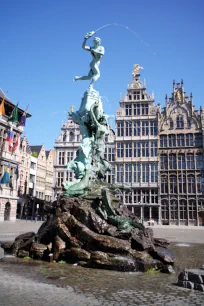
Brabo Fountain
The centerpiece of the square is a large fountain, built in 1887 by the architect Jef Lambaux. It depicts the protagonist of Antwerp’s most famous legend: the mythical hero Brabo.
According to the legend, the giant Antigoon demanded a high toll for each ship that wanted to enter the city. If the ship’s crew did not want to pay the toll, their hands were cut off. The hero Brabo fought the giant, cut its hand and head and threw the hand in the river.
The fountain’s statue depicts Brabo throwing the giant’s hand in the River Scheldt and symbolizes the free passage through the river. As such, it is a political swipe at the Dutch, who long blocked (and still continue to hinder) free traffic on the Scheldt.
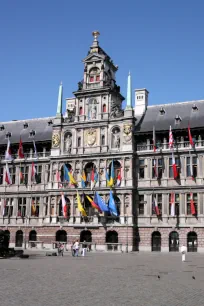
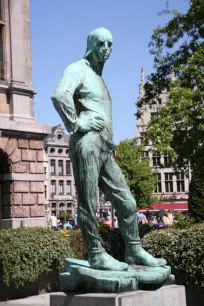
City Hall
The most impressive building on the Grote Markt is undoubtedly the magnificent stadhuis (city hall), built in 1561-1565 in Flemish Renaissance style. Before its construction, the houses with typical stepped gables behind the city hall marked the border of the Grote Markt.
The building is lavishly decorated with ornaments and boasts a sumptuous interior that was redecorated in the nineteenth century. Seemingly countless flags representing countries that have a consulate in Antwerp hang from the front facade.
The Dockworker
Next to the city hall stands a bronze statue that honors the dockworkers. It was created in 1885 by the Belgian artist Constantin Meunier, who was inspired by the harsh labor conditions in the docks during the 19th century. The sculpture shows a young stevedore – a dockworker who manually loaded and unloaded ships. His headgear was made specifically for carrying large bags.
In 1946 this statue, a cast from 1893, was donated by an American general to the city of Antwerp out of gratitude for the dockworkers who continued working despite the constant terror of the German V-bombs. The statue, which is known as the «Buildrager» (stevedore) was unveiled here on September 4, 1950.

